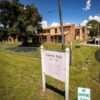April 26, 2006. Herald-Tribune.
SARASOTA — A coalition of 21 churches is becoming impatient with the city because it has yet to expand a redevelopment district into Newtown and devote millions of dollars to affordable housing there.
Sarasota United for Responsibility and Equity, known as SURE, is calling for the city to complete all of the legal work required to redefine the district’s boundaries within two months and for the County Commission to quickly agree to the changes.
“It’s not just about money,” the Rev. James F. Kelly of St. Wilfred Episcopal Church said at a SURE rally on Thursday night. “It’s about people who need a place to live, who need a living wage, who live in our community and want to live in our community.”
More than 200 supporters came to St. Martha’s Catholic Church for what SURE called “a public action.”
They heard a mostly receptive response to their demands from Mayor Fredd Atkins, City Commissioner Mary Anne Servian and County Commissioner Paul Mercier.
Servian said the city’s work on expanding its Community Redevelopment Area into Newtown has moved along at “a snail’s pace” because of the legal research involved.
Yet she felt that work could be completed and in the County Commission’s hands within 60 days.
County Commissioner Paul Mercier said he thought the county would sign off on the changes.
“I don’t see why we wouldn’t want to cooperate to bring that money into other areas of the community,” Mercier said.
In August, SURE representatives presented the City Commission with a petition signed by more than 1,000 residents.
The petitioners called for Sarasota to use at least half of the property taxes collected for its Community Redevelopment Area to subsidize housing for low- to moderate-income workers who are getting priced out of the city’s soaring real estate market.
The city created the CRA in 1986, freezing the amount of property taxes it receives from that downtown zone for its general fund. The county participated.
As property values in the area rose, the additional taxes went into CRA projects such as downtown parks, streetscapes and public-private redevelopments, such as the Whole Foods market and the new Herald-Tribune headquarters.
Since the CRA’s inception, affordable housing has been listed as a proper use for its funds. Yet no dollars were ever appropriated for it.
“Now we’re priced out of downtown and that’s our own fault,” Atkins said.
SURE contends that if the CRA’s boundaries are extended out of downtown, where land and construction costs are highest, and north into the lower-income Newtown neighborhood, the city could kick off a lot of affordable housing construction and renovation.
SURE spokesman John McGruder said the organization wants the city to pledge no less than $25 million of CRA funds during the next nine years toward affordable housing.
The CRA is set to expire in 2015.
Yet Servian said the city is not prepared to make that pledge.
“I don’t know what the proper number is,” Servian said. The City Commission “will have that debate at the table and make that decision.”
The Housing Authority is also interested in seeing the CRA expanded into Newtown. The authority needs a variety of funding sources to redevelop four blighted public housing complexes there.
The use of CRA dollars for affordable housing would not be unprecedented in this area.
In 2002, Palmetto’s CRA contributed $460,000 to raze a dilapidated apartment complex and help acquire the land for a new subdivision built by Manatee County Habitat for Humanity.





